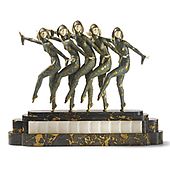Demétre Chiparus
Demétre Haralamb Chiparus , actually Dumitru Haralamb Chipăruș (born September 16, 1886 in Dorohoi , Kingdom of Romania , † January 22, 1947 in Paris , France ), was a Romanian sculptor and ceramist . With the design of his chryselephantine sculptures, he is one of the most important artists of Art Deco . His works mostly depict dancers from the Ballets Russes , symbolizing the modern woman.
Chiparus' Chryselephantines have a high decorative effect due to their elegant clothes made of bronze , enamel and paint, the strong stylization of the faces made of ivory and their long, slim appearance. They are among the best-selling sculptures of the Art Deco period. Most of them were made between 1914 and 1933.
Life
Dumitru was born to Haralamb and Saveta Chipăruș. In 1909 he went to Italy , where he studied with the Italian sculptor Raffaello Romanelli . In 1912 he moved to Paris, where he attended the École des Beaux-Arts . There he received lessons from Antonin Mercie and Jean Boucher . Here Chiparus perfected his chryselephantine technique, in which he combined bronze and ivory and decorated the bronze elements mostly by cold painting or enamelling . His special focus was less on the quality of the ivory carving than on the jewel-like decor of the bronze surfaces, which gave his work an independent appearance.
His first series consisted of children's sculptures that came very close to the style of realism . It was shown in 1914 at the Paris Salon of the Société des Artistes Indépendants , where Chiparus exhibited continuously from 1914 to 1928; including the javelin thrower in 1923 and the Ta Keo dancer in 1928 . Until the Second World War , Chiparus' work was carried out by the foundries Edmond Etling & Cie and Les Neveux de Jules Lehmann as well as Arthur Goldscheider , but the living conditions for sculptors in France deteriorated dramatically as a result of the German occupation of the country.
Chiparus had been producing animal sculptures in the Art Deco style since the early 1940s, but no longer primarily worked for sales, but on his own initiative. At his last exhibitions in the Paris Salon in 1942 he showed the plaster sculpture polar bear and buffalo and in 1943 his polar bear made of marble and a pelican made of plaster.
The largest collection of his works is today with 120 original pieces in the Art Deco Museum in Moscow .
style
Chiparus drew his inspiration mainly from fashion, films and the French theater of his time, but also from Diaghilev's ballets and the stage design of Leon Bakst . Some of his sculptures were directly influenced by Russian dancers, such as Vaslav Nijinsky and Ida Rubinstein . Chiparus also used photos of Russian and French dancers and models from the fashion magazines of the time.
The sculptures also testify to Chiparus' interest in Egypt . After the tomb of Pharaoh Tutankhamun was opened in 1922, ancient Egyptian and Eastern art found its way into French fashion. Several of his sculptures embody the Egyptian queen Cleopatra and Egyptian dancers.
With their elegance and luxury, Chiparus' works embody the spirit of the Art Deco era at its height.
literature
- Alberto Shayo : Chiparus. Master of Art Deco. Abbeville Press, 1999. ISBN 0-78920-594-7 , 216 pp.
- Alberto Shayo: Statuettes art deco period. Antique Collectors Club Art Books, 2016. ISBN 1-85149-824-9 . P. 44.
- Bryan Catley: Art Deco and other Figures . Woodbridge, Suffolk 2003. ISBN 1-85149-382-4 , 384 pp.
- Robert E. Dechant, Filipp Goldscheider: Goldscheider. Company history and catalog raisonné . Arnoldsche Art Publishers. ISBN 978-3-89790-216-9 . 640 p.
Web links
- Chiparus in the museum guide of the Museo Art Nouveau y Art Déco Casa Lis, Salamanca, Spain ( Memento from November 5, 2010 in the Internet Archive ) (PDF file; 552 kB)
Individual evidence
- ^ To Art Deco Paradise in Moscow's New Museum. In: The Moscow Times, August 20, 2015.
| personal data | |
|---|---|
| SURNAME | Chiparus, Demétre |
| ALTERNATIVE NAMES | Chipăruș, Dumitru Haralamb (real name) |
| BRIEF DESCRIPTION | Romanian Art Deco sculptor and ceramist |
| DATE OF BIRTH | September 16, 1886 |
| PLACE OF BIRTH | Dorohoi , Kingdom of Romania |
| DATE OF DEATH | January 22, 1947 |
| Place of death | Paris , France |



